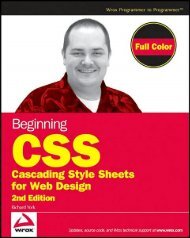O Guia Definitivo do Yii 1.1
O Guia Definitivo do Yii 1.1
O Guia Definitivo do Yii 1.1
Create successful ePaper yourself
Turn your PDF publications into a flip-book with our unique Google optimized e-Paper software.
widgets that generate a lot of HTML markup, it is best to use view files specific to the<br />
widget to contain the markup.<br />
• Helper classes: in views we often need some code snippets to <strong>do</strong> tiny tasks such as<br />
formatting data or generating HTML tags. Rather than placing this code directly into<br />
the view files, a better approach is to place all of these code snippets in a view helper<br />
class. Then, just use the helper class in your view files. <strong>Yii</strong> provides an example of<br />
this approach. <strong>Yii</strong> has a powerful CHtml helper class that can produce commonly<br />
used HTML code. Helper classes may be put in an autoloadable directory so that<br />
they can be used without explicit class inclusion.<br />
Controller<br />
Controllers are the glue that binds models, views and other components together into a<br />
runnable application. Controllers are responsible for dealing directly with end user<br />
requests. Therefore, controllers<br />
• may access $_GET, $_POST and other PHP variables that represent user requests;<br />
• may create model instances and manage their life cycles. For example, in a typical<br />
model update action, the controller may first create the model instance; then populate<br />
the model with the user input from$_POST; after saving the model successfully, the<br />
controller may redirect the user browser to the model detail page. Note that the actual<br />
implementation of saving a model should be located in the model instead of the<br />
controller.<br />
• should avoid containing embedded SQL statements, which are better kept in models.<br />
• should avoid containing any HTML or any other presentational markup. This is better<br />
kept in views.<br />
In a well-designed MVC application, controllers are often very thin, containing probably<br />
only a few <strong>do</strong>zen lines of code; while models are very fat, containing most of the code<br />
responsible for representing and manipulating the data. This is because the data structure<br />
and business logic represented by models is typically very specific to the particular<br />
application, and needs to be heavily customized to meet the specific application<br />
requirements; while controller logic often follows a similar pattern across applications and<br />
therefore may well be simplified by the underlying framework or the base classes.










